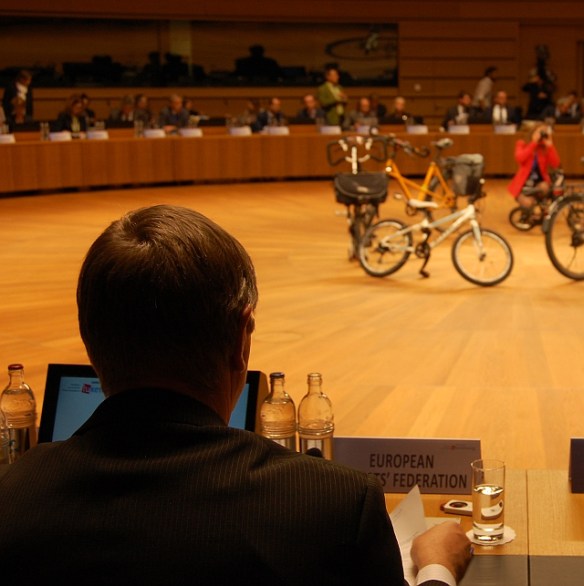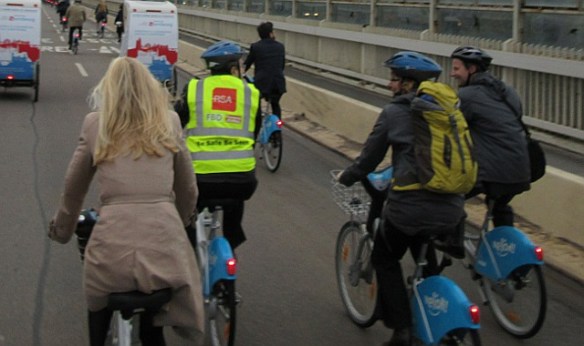Those of my readers who also follow cycling politics in Europe should know by now that this was a huge week for the organisation I work for. On Wednesday we were in Luxembourg for the first ever EU Cycling Summit, organised by the government of Luxembourg as its main transport event as part of their six month turn as the Presidency of the EU.
All the coverage of that event and its policy importance are covered extensively on the ECF web site, here on my personal site I have the opportunity to reflect just a little on the atmosphere and of course the cycling.
I may have worked in the cycle campaigning and policy arena for a few years but our team really didn’t know quite what to expect because this was way, way, beyond our normal sphere of influence. The main room for the meeting was quite intimidating for us novices, it was the full EU debating chamber with front row seats for the ministers and heads of delegation and behind them the support staff, all trying to show that they were engaged in important political work, or in most cases checking their bosses’ email and tweeting from the room.
I was certainly doing the Twitter part, I think I must have had a record day on line. (Those without Twitter can see all my Tweets on this site’s home page and Idonotdespair’s Facebook page)
What I will remember more than anything is two things. Firstly the obvious enthusiasm for cycling of some of the people in the room. Their day job is clearly the minutiae of policy detail, or the broad sweep of political influence. We know they were going to have a hard second day discussing sensitive issues like the ramification of the Volkswagen Diesel emissions scandal. But at this so called “informal summit” they could break ranks and speak with passion and enthusiasm about a topic they clearly enjoyed. Yes there were also those who delivered prepared statements on behalf of their governments but there was no doubting the smile on the face of many of them, especially when they added a personal dimension.
And secondly of course there was a bike ride. Yet again it delivered as John F. Kennedy said it would because “nothing compares to the simple pleasure of a bike ride.” All those people who had been formally set around the chamber went out onto the wet and windy plateau of Luxembourg’s business district and started smiling.
The hosts had laid on 100 bikes and few pedicabs for the delegations, but also a fleet of ministerial mini-buses really expecting that many present might maintain a policy of being pro-cycling but consider themselves far too important to get exposed to the elements. Not a chance, to the point that my colleague Fabian and I got stuck at the end with only one bike between us, which he generously conceded to me.
And off we rode. As far as I know 19 Ministers, the EU Transport Commissioner, the Chair of the EU Transport Committee, a Luxembourgish Tour de France star (Andy Schleck) and about 80 more friends of cycling enjoyed a closed road tour across the impressively high bridge that links the Kirchberg plateau to the old city. Through the increasingly dark city streets we pedalled to our dinner in the grand Cercle-Cité, a landmark that once housed one of the founding institutions of the body that became the EU.
I am supposed to have created ECF’s official photographic record of who was there, who rode and spoke but I have found it almost impossible to reconcile faces and names entirely, that remains a future job for our members. Political cycling junkies can look out for the 19 ministers – officially recorded as Luxembourg, France, Germany, Bulgaria, Finland, Cyprus, Ireland, Slovenia, Sweden, Netherlands, Italy, Austria, Czech Republic, Poland, Malta, Greece, Hungary, Latvia, Romania and Norway.
And of these only one failed the “simple pleasure” test. Most just rode and enjoyed themselves with their colleagues in the day clothes that they wore at the meeting, just as one should when cycle commuting. Just one felt the need to dress up like a complete dork in the high viz vest and helmet that he was presumably told he should wear, in case anyone from home was watching. Hopefully he felt as out of place as he looked.
But not to end on a grumpy note, it was a great day, moving and even a little humbling to hear 14 nations speak up directly for cycling in that setting. I will remember it for a long time and I hope we will remember it as a bit of breakthrough day for policy too. That part is harder, however I can safely say “We’ll always have Luxembourg” as Humphrey Bogart almost said to Ingrid Bergman in the closing sequence of Casablanca.



























Sadly that must be the Irish delegation wearing the helmets with one of them even wearing an RSA Ireland hi vis vest. The authorities in Ireland keep on pushing helmets and hi vis but not spending enough money or time protecting cyclists with infrastructure and enforcement. They are clearly out of step with the rest of the EU, as this picture demonstrates. Will only EU intervention saves us from this victim blaming madness ?
LikeLike
In response to you Kevin and numerous on line commentary from the Irish cycling community on Twitter I would make the following observation.
The “hi-viz and helmet” was so obvious to me because it was so out of character with all the other participants. It is extraordinary that this person could not look around and see that 100 other participants riding in a group, car free, police escort front and rear presented no apparent risk to his health and safety, indeed that they were happy to be riding in their daily clothes and smiling.
Or perhaps, as I hinted above, the person did see what was going on but felt bound by some national policy perspective to carry on regardless. If so that is equally sad.
I would have made the same comment if someone had turned up in head to toe lycra in this context, it showed such a lack of comprehension of daily cycling, in fact I said something similar for a Bike to Work ride in Australia last year. (But here even the Tour De France rider was in a suit!)
LikeLike
The person wearing the RSA hi-viz and helmet was not part of the Irish Government delegation. I was, and neither myself nor my Department colleague nor the Minister wore hi-viz or helmets.
LikeLike
That is good to know from the official side Derek.
The on line Irish community was very quick to spot the RSA logo, I wasn’t particularly aware that that it was an Irish campaign until I started seeing all the reaction on Twitter.
Now intrigued to find out who the mystery man was, he certainly wanted to make an impression and gave the social media something to comment on.
Kevin
LikeLike
Although the sole effect of the single @RSAIreland hi-vis vest was to draw attention to its wearer, I do feel uncomfortable focusing on an individual participant in the Luxembourg ministerial cycling group.
However, it also must be said that the particular item of hi-vis, bearing the RSA logo, afforded an opportunity to critique a peculiar aspect of Ireland’s road safety policy and culture in relation to cycling and walking, ie an almost neurotic compulsion to drape cyclists and pedestrians in fluorescent fabric.
Much of this ‘hivisteria’ is driven by Ireland’s Road Safety Authority, which is said to have distributed five million hi-vis items since 2007 (https://lc.cx/Z9Dk) and reportedly purchases one million hi-vis vests every year (http://lc.cx/Z9RC).
According to the 2011 Census, the population of the Republic of Ireland is just over 4.5 million.
The proportion of commuters cycling to work was 2.4% in the 2011 census, which compares very unfavourably with the 7.2% recorded in 1986 (https://lc.cx/ZCHA). Cycling has undergone a resurgence in recent years, albeit from a very low base. This is in spite of, rather than because of, the constant portrayal of cycling as a risky activity requiring special Personal Protective Equipment (PPE).
While hi-vis may be highly visible in certain conditions, there is no clear evidence that wearing such fabric makes a significant positive difference in terms of sustainable safety and actual casualty reductions. In contrast, the implementation and enforcement of lower speed limits (such as 30 km/h zones), for example, is of proven benefit for all road users, reducing fatalities and serious injuries while providing a conducive environment for walking and cycling.
Legislation enabling the creation of 30 km/h zones has been on the Irish statute book since 2004, yet implementation has been paltry. A 2014 survey of local authorities carried out by the Irish Department of Transport found that just 1.5% of residential areas outside Dublin had a 30 km/h speed limit, while in the capital city only three localities had this lower speed limit imposed.
Yet the RSA has no statutory role in the setting of speed limits, implementation of speed limits in local authority administrative areas or the enforcement of speed limits. Furthermore, apart from including a reference to 30 km/h in its National Pedestrian Safety Action Plan (https://lc.cx/ZCHM), the RSA has had very little to say to local or national government about such low speed zones. It is perhaps for this reason that, in relation to cycling and walking, the RSA’s overwhelming emphasis in its actions is on PPE, the Safe Cross Code and other educational strategies targeted at individuals. The RSA has very little actual authority to engineer a safer environment for cyclists and pedestrians, which is what makes a real, sustainable difference.
Likewise the Department of Transport, while it has issued a circular to local authorities “requiring an examination of speed limits in residential areas and housing estates” (https://lc.cx/ZCHN) does not seem to be able to force Councils to act, and the Minister reportedly believes that there are problems with “blanket speed limits” even though there is already a default speed limit in all urban areas, ie 50 km/h.
It is for these and other reasons that long-time campaigners for cycling and walking have little patience with strategies based on draping large swathes of the country in gaudy fabric.
LikeLike